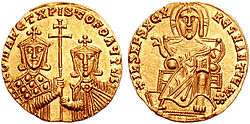Christopher Lekapenos
| Christopher Lekapenos | |
|---|---|
| Co-emperor of the Byzantine Empire | |
 | |
| Reign | 921–931 |
| Dynasty | Lekapenos |
| Father | Romanos Lekapenos |
| Mother | Theodora |
Christopher Lekapenos or Lecapenus (Greek: Χριστόφορος Λακαπηνός) was the eldest son of Emperor Romanos I Lekapenos (r. 920–944) and co-emperor from 921 until his death in 931.
Life
Christopher was the oldest son of Romanos Lekapenos, and the second-oldest child after his sister Helena. Younger siblings were Agatha, who married Romanos Argyros, Stephen and Constantine (co-emperors from 924 until 945), Theophylact (Patriarch of Constantinople in 933–956), and two unnamed younger sisters.[1][2]
Nothing is known of Christopher's early life. He was certainly an adult by 919–920, and had a daughter of marriageable age in 927,[3] hence he was probably born around 890–895. Already before his father's rise to power, he had been married to Sophia, the daughter of the wealthy patrikios Niketas, a Slav from the Peloponnese.[4]
When Romanos succeeded in having his daughter Helena Lekapene married to the young emperor Constantine Porphyrogennetos in spring 919 and assumed the role of guardian of the emperor with the title basileopator, Christopher succeeded him in his post as megas hetaireiarches, commander of the palace guard.[5][6] Romanos soon crowned himself emperor (December 920), and eventually advanced himself before the young Constantine in precedence. To further cement his position, and planning to advance his own family over the legitimate Macedonian line, Romans crowned Christopher also as co-emperor on 20 May 921.[3][6][7] Furthermore, when Christopher's mother, the Augusta Theodora died in February 922, his wife Sophia was raised to the dignity of Augusta alongside Helena Lekapene.[8]
In 927, as part of a peace agreement, Christopher's daughter Maria, renamed Eirene ("peace") for the occasion, was married to the Bulgarian emperor Peter I (r. 927–969).[9] Romanos used the occasion to advance Christopher before Constantine Porphyrogennetos, making him first among the rather large group of co-emperors (in 924, Christopher's younger brothers Stephen and Constantine had also been crowned as co-emperors).[3][6][10] In 928, his father-in-law, the patrikios Niketas, unsuccessfully tried to incite Christopher to depose his father, and was banished. The motive behind this was perhaps Christopher's poor health, and fears by his wife and her father that, should he die prematurely, they would lose their status.[6][11] In the event, Christopher died in August 931, much mourned by his father, who shed tears "like the Egyptians" and thereafter increasingly became devoted to religious pursuits. Soon after Christopher's death, Sophia too retired from the court and entered a monastery, where she died.[12][13]
Family
Through his marriage to Sophia, Christopher had three children:[1][12]
- Maria-Eirene (died ca. 965), the Empress-consort of Peter I of Bulgaria.[9][14]
- Romanos, still a child at the time of Christopher's death. According to Zonaras he was favoured by his grandfather, who thought about promoting him to his father's place as senior co-emperor, but for his death soon after.[12]
- Michael, an infant at the time of Christopher's death, he was made a cleric at the time of the family's fall from power in 945. He eventually reached the high dignities of magistros and rhaiktor, but nothing further is known of his later life.[15]
References
- 1 2 Kazhdan (1991), p. 1204
- ↑ Cawley, Cawley, Charles, ROMANOS LEKAPENOS, Medieval Lands database, Foundation for Medieval Genealogy,
- 1 2 3 Grierson & Bellinger (1973), p. 528
- ↑ Runciman (1929), p. 64
- ↑ Runciman (1929), p. 60
- 1 2 3 4 Kazhdan (1991), p. 442
- ↑ Runciman (1929), pp. 65–66
- ↑ Runciman (1929), p. 67
- 1 2 Charles William Previté-Orton (1975) Cambridge Medieval History, Shorter: Volume 1, The Later Roman Empire to the Twelfth Century. Volume 1 of The Shorter Cambridge Medieval History, ISBN 0-521-09976-5 p. 256
- ↑ Runciman (1929), pp. 67, 97
- ↑ Runciman (1929), pp. 71–72
- 1 2 3 Runciman (1929), p. 78
- ↑ Grierson & Bellinger (1973), p. 526
- ↑ Runciman (1929), pp. 78, 237
- ↑ Runciman (1929), pp. 78, 234
Sources
- Grierson, Philip; Bellinger, Alfred Raymond, eds. (1973), Catalogue of the Byzantine Coins in the Dumbarton Oaks Collection and in the Whittemore Collection, vol. 3: Leo III to Nicephorus III, 717–1081, Dumbarton Oaks, ISBN 978-0-88402-045-5
- Kazhdan, Alexander, ed. (1991), Oxford Dictionary of Byzantium, Oxford University Press, ISBN 978-0-19-504652-6
- Runciman, Steven (1988) [1929], The Emperor Romanus Lecapenus and His Reign: A Study of Tenth-Century Byzantium, Cambridge University Press, ISBN 978-0-521-35722-7